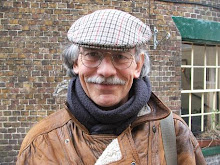


















THE TOM PAINE PRINTING PRESS is now at 151 High Street, Lewes, East Sussex, BN7 1XU, UK. It is Peter Chasseaud's project for a working 18th-century ‘common press’ in the environment of an 18th century printing house, with type cases, cabinets, frames and the compositor’s ‘stone’. Posters, broadsheets, pamphlets and books will be printed on the press, which will also be used to show the complexities of letterpress technology and the crucial importance of the printed word in disseminating ideas.



















 Alan May has just sent me this photo of the Common Press (destined for The Tom Paine Printing Press in Lewes) under construction in his workshop. Sitting on it are parts of four miniature presses which he is also constructing. The full-size press will be operational for the Tom Paine bicentenary in July 2009.
Alan May has just sent me this photo of the Common Press (destined for The Tom Paine Printing Press in Lewes) under construction in his workshop. Sitting on it are parts of four miniature presses which he is also constructing. The full-size press will be operational for the Tom Paine bicentenary in July 2009. Alan May, who built the Gutenberg Press, is (in grey shirt) standing by the press. His assistant is showing the audience a printed page which has just been pulled from the press.
Alan May, who built the Gutenberg Press, is (in grey shirt) standing by the press. His assistant is showing the audience a printed page which has just been pulled from the press.
Above: Alan May (left) and Peter Chasseaud (right)
 Above: Alan May with his miniature 18th Century Common Press. This is a quarter-size model of the full-size press he is building for The Tom Paine Press.
Above: Alan May with his miniature 18th Century Common Press. This is a quarter-size model of the full-size press he is building for The Tom Paine Press.
 A page of the Gutenberg Bible printed during the demonstration by Alan May and his assistant.
A page of the Gutenberg Bible printed during the demonstration by Alan May and his assistant. Peter Chasseaud inspecting a printed page from the Gutenberg Bible (paper and ink still damp).
Peter Chasseaud inspecting a printed page from the Gutenberg Bible (paper and ink still damp). The type and tympan on the bed of the Gutenberg Press.
The type and tympan on the bed of the Gutenberg Press. Type mould constructed by Alan May. When closed, hot metal (an alloy of lead and antimony) is poured in; this immediately solidifies into a piece of type. Prior to this, the positive of the letter to be cast is sculpted from a steel bar, which is then struck into a bronze matrix to create the negative form of the letter. This matrix is fixed into the mould, the two halves of which are held together with the wire spring-clips shown. Once the matrix has been made, it can be re-used in the mould almost indefinitely, so type can be mass-produced.
Type mould constructed by Alan May. When closed, hot metal (an alloy of lead and antimony) is poured in; this immediately solidifies into a piece of type. Prior to this, the positive of the letter to be cast is sculpted from a steel bar, which is then struck into a bronze matrix to create the negative form of the letter. This matrix is fixed into the mould, the two halves of which are held together with the wire spring-clips shown. Once the matrix has been made, it can be re-used in the mould almost indefinitely, so type can be mass-produced. Peter Chasseaud (left) with the inking balls (on the ink slab). These are made from leather, horsehair and wood, The ink is picked up off the slab with a circular rolling motion, and applied to the type with a similar motion. To keep the leather soft and supple, it was (in the 18th Century!)steeped in urine.
Peter Chasseaud (left) with the inking balls (on the ink slab). These are made from leather, horsehair and wood, The ink is picked up off the slab with a circular rolling motion, and applied to the type with a similar motion. To keep the leather soft and supple, it was (in the 18th Century!)steeped in urine.
 I acquired this Arab treadle platen press, with 70 cases of type, in about 1988, and set it up in the Star Brewery in Lewes, where I shared a space with four other artists and also did my paintings (see my blog: http://peterchasseaud.blogspot.com). The press and type came originally from the Ditchling Press, and the word was that it had been used by David Jones and Eric Gill.
I acquired this Arab treadle platen press, with 70 cases of type, in about 1988, and set it up in the Star Brewery in Lewes, where I shared a space with four other artists and also did my paintings (see my blog: http://peterchasseaud.blogspot.com). The press and type came originally from the Ditchling Press, and the word was that it had been used by David Jones and Eric Gill. Introduction by Peter Chasseaud (see also my blog http://peterchasseaud.blogspot.com/):
Introduction by Peter Chasseaud (see also my blog http://peterchasseaud.blogspot.com/):
